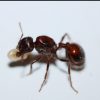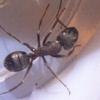Recently I went up to the mountains in Shaver lake to relax at the cabin. While my dad was chopping wood he split into a couple logs with ants and a couple logs loaded with dry wood termites. Knowing how much I love ants he told me about this and I asked if he could please show me which logs and if he could split them. The logs were all in 1 large pile. the termite and ant infested logs were located next to the soil under the log pile, under a heavily shaded area surrounded by pine trees in shaver lake at an elevation of 5500 feet.
When he first split the logs I wasnt sure there were even ants in there. However, once he split the first soft, wet log thousands of large fat dry wood termites fell out and dispersed everywhere. I have come into contact with these termites once before but never saw the soldiers, and let me tell you they are HUGE and kind of scary. I found it interesting that the termites and the formica ants were living in logs basically right next to each other.
The next log he split was crawling with these medium sized black ants. Having worked extensively with Pogonomyrmex californicus I'd say they were almost the same size as them but their gasters were larger. Upon closer inspection of the black ants I noticed first that there were no eggs/larvae/pupae present. The second thing I noticed was I saw about 5-8 queens crawling around, so I knew they were polygynous. I didn't have my lens with me to take any close pictures but at this point I knew they were some kind of formica. When I got home yesterday I took some close ups and here they are. I now have a small colony of these girls with about 100 workers and 5-7 queens. Any advice/identification confirmation would be greatly appreciated. Thank you for reading and I hope this journal will be helpful to future Formica fusca enthusiasts.


































